MG630 Change Management & OD: Barnacle Bay Hotel Case Analysis
VerifiedAdded on 2023/06/18
|8
|2638
|210
Report
AI Summary
This report analyzes the change management challenges and organizational development strategies at Barnacle Bay Country House Hotel. It assesses the impact of unplanned changes, such as competition from Peacock Hall and Brexit, on the hotel's operations. The report provides guidance to Rita, the hotel owner, on implementing a planned approach to change, utilizing Lewin's change management model (unfreezing, change, freezing) and various organizational development approaches to enhance competitiveness and improve customer service. Furthermore, it addresses potential conflicts arising from these changes and offers recommendations for mitigating resistance and fostering employee engagement. The analysis emphasizes the importance of continuous improvement, cleanliness, and employee motivation to ensure the long-term success and profitability of the hotel. Desklib offers students access to similar solved assignments and past papers.
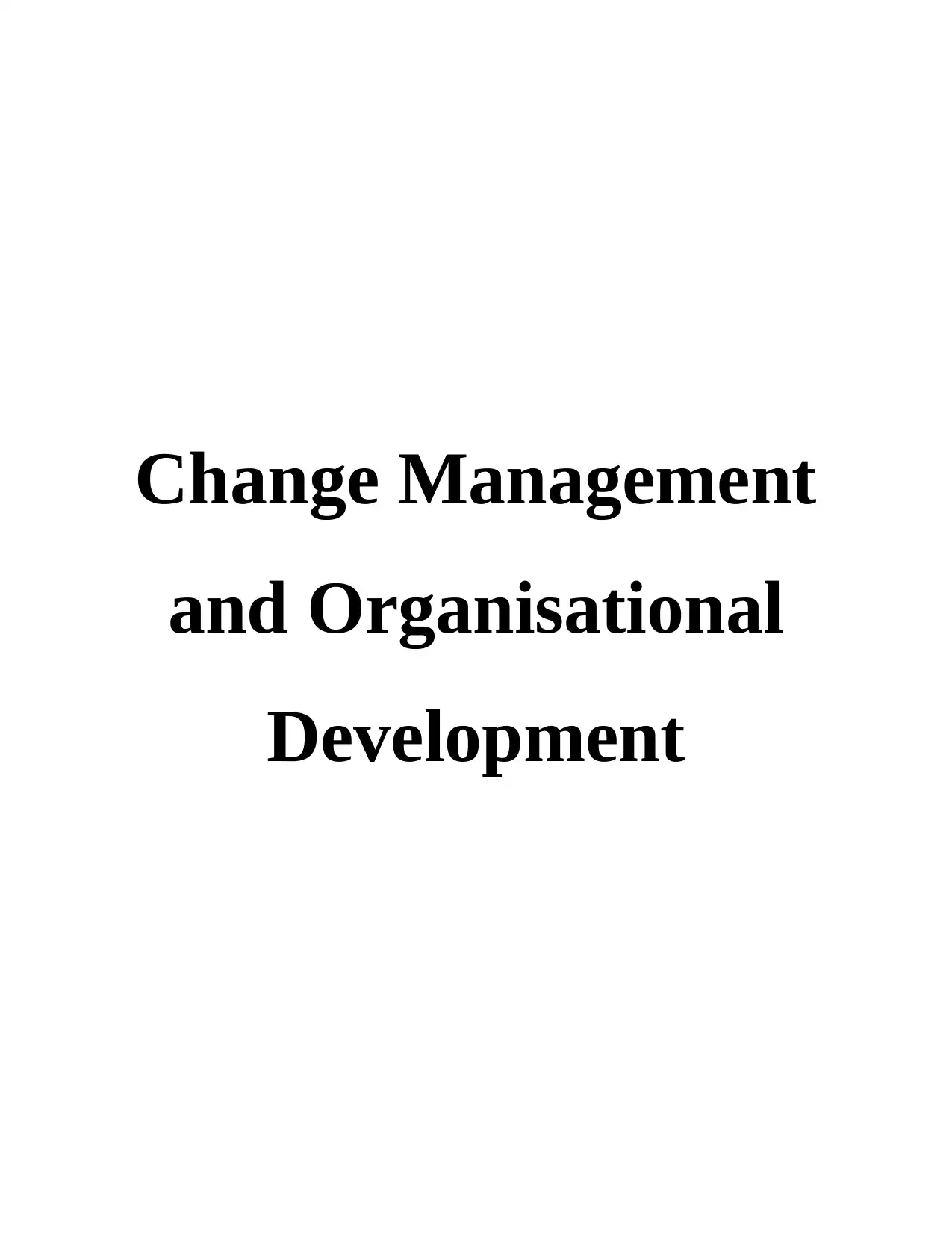
Change Management
and Organisational
Development
and Organisational
Development
Paraphrase This Document
Need a fresh take? Get an instant paraphrase of this document with our AI Paraphraser
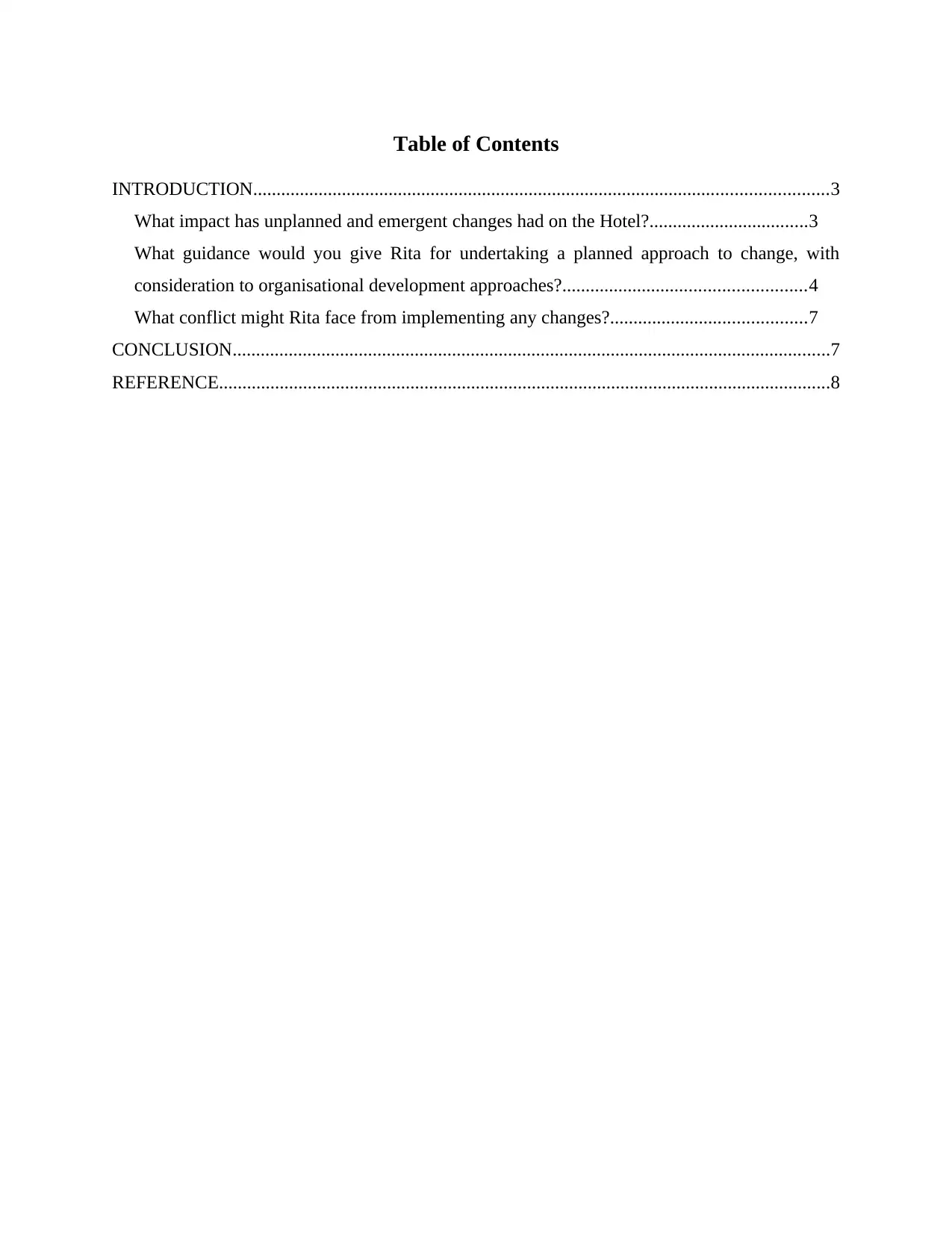
Table of Contents
INTRODUCTION...........................................................................................................................3
What impact has unplanned and emergent changes had on the Hotel?..................................3
What guidance would you give Rita for undertaking a planned approach to change, with
consideration to organisational development approaches?....................................................4
What conflict might Rita face from implementing any changes?..........................................7
CONCLUSION................................................................................................................................7
REFERENCE...................................................................................................................................8
INTRODUCTION...........................................................................................................................3
What impact has unplanned and emergent changes had on the Hotel?..................................3
What guidance would you give Rita for undertaking a planned approach to change, with
consideration to organisational development approaches?....................................................4
What conflict might Rita face from implementing any changes?..........................................7
CONCLUSION................................................................................................................................7
REFERENCE...................................................................................................................................8
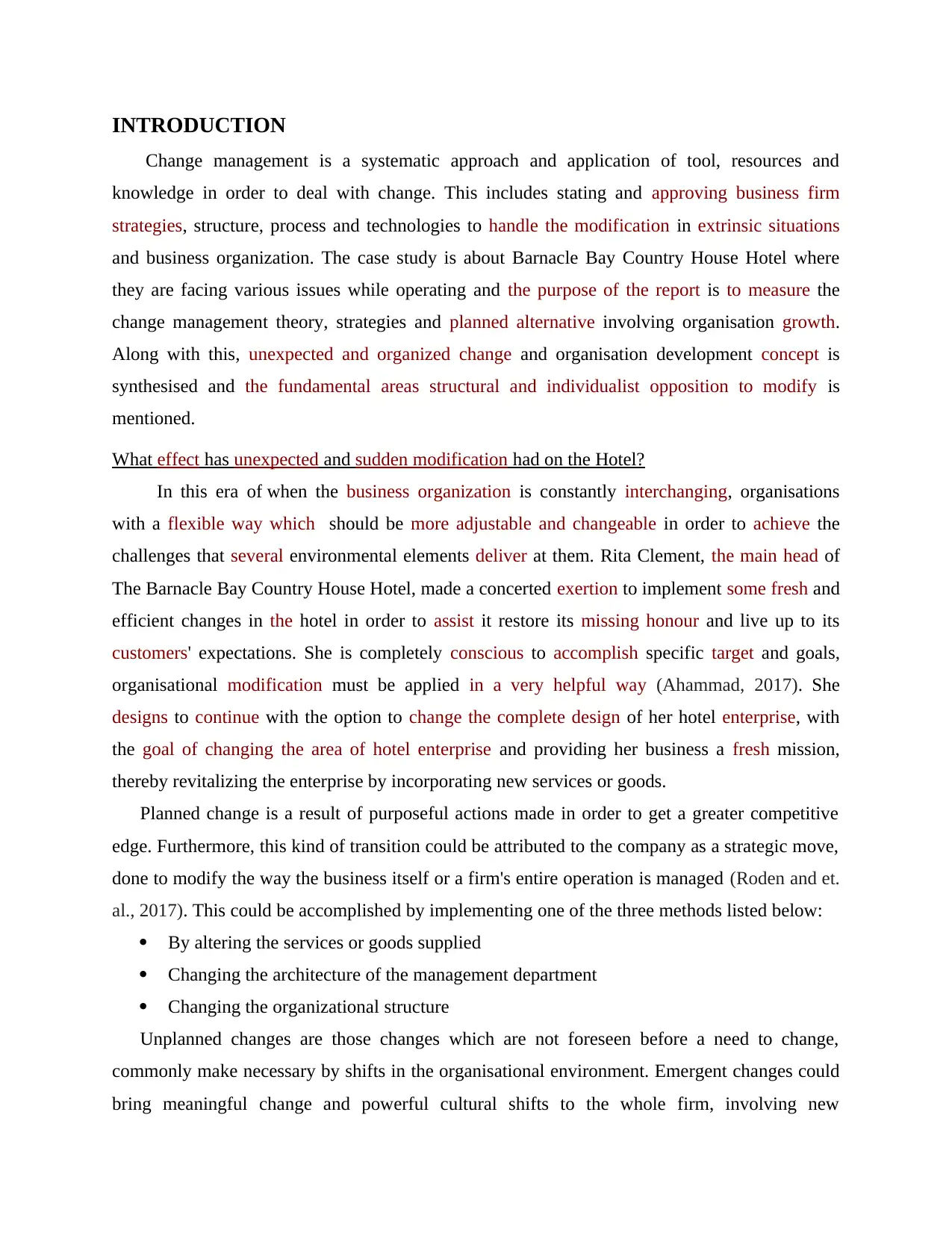
INTRODUCTION
Change management is a systematic approach and application of tool, resources and
knowledge in order to deal with change. This includes stating and approving business firm
strategies, structure, process and technologies to handle the modification in extrinsic situations
and business organization. The case study is about Barnacle Bay Country House Hotel where
they are facing various issues while operating and the purpose of the report is to measure the
change management theory, strategies and planned alternative involving organisation growth.
Along with this, unexpected and organized change and organisation development concept is
synthesised and the fundamental areas structural and individualist opposition to modify is
mentioned.
What effect has unexpected and sudden modification had on the Hotel?
In this era of when the business organization is constantly interchanging, organisations
with a flexible way which should be more adjustable and changeable in order to achieve the
challenges that several environmental elements deliver at them. Rita Clement, the main head of
The Barnacle Bay Country House Hotel, made a concerted exertion to implement some fresh and
efficient changes in the hotel in order to assist it restore its missing honour and live up to its
customers' expectations. She is completely conscious to accomplish specific target and goals,
organisational modification must be applied in a very helpful way (Ahammad, 2017). She
designs to continue with the option to change the complete design of her hotel enterprise, with
the goal of changing the area of hotel enterprise and providing her business a fresh mission,
thereby revitalizing the enterprise by incorporating new services or goods.
Planned change is a result of purposeful actions made in order to get a greater competitive
edge. Furthermore, this kind of transition could be attributed to the company as a strategic move,
done to modify the way the business itself or a firm's entire operation is managed (Roden and et.
al., 2017). This could be accomplished by implementing one of the three methods listed below:
By altering the services or goods supplied
Changing the architecture of the management department
Changing the organizational structure
Unplanned changes are those changes which are not foreseen before a need to change,
commonly make necessary by shifts in the organisational environment. Emergent changes could
bring meaningful change and powerful cultural shifts to the whole firm, involving new
Change management is a systematic approach and application of tool, resources and
knowledge in order to deal with change. This includes stating and approving business firm
strategies, structure, process and technologies to handle the modification in extrinsic situations
and business organization. The case study is about Barnacle Bay Country House Hotel where
they are facing various issues while operating and the purpose of the report is to measure the
change management theory, strategies and planned alternative involving organisation growth.
Along with this, unexpected and organized change and organisation development concept is
synthesised and the fundamental areas structural and individualist opposition to modify is
mentioned.
What effect has unexpected and sudden modification had on the Hotel?
In this era of when the business organization is constantly interchanging, organisations
with a flexible way which should be more adjustable and changeable in order to achieve the
challenges that several environmental elements deliver at them. Rita Clement, the main head of
The Barnacle Bay Country House Hotel, made a concerted exertion to implement some fresh and
efficient changes in the hotel in order to assist it restore its missing honour and live up to its
customers' expectations. She is completely conscious to accomplish specific target and goals,
organisational modification must be applied in a very helpful way (Ahammad, 2017). She
designs to continue with the option to change the complete design of her hotel enterprise, with
the goal of changing the area of hotel enterprise and providing her business a fresh mission,
thereby revitalizing the enterprise by incorporating new services or goods.
Planned change is a result of purposeful actions made in order to get a greater competitive
edge. Furthermore, this kind of transition could be attributed to the company as a strategic move,
done to modify the way the business itself or a firm's entire operation is managed (Roden and et.
al., 2017). This could be accomplished by implementing one of the three methods listed below:
By altering the services or goods supplied
Changing the architecture of the management department
Changing the organizational structure
Unplanned changes are those changes which are not foreseen before a need to change,
commonly make necessary by shifts in the organisational environment. Emergent changes could
bring meaningful change and powerful cultural shifts to the whole firm, involving new
⊘ This is a preview!⊘
Do you want full access?
Subscribe today to unlock all pages.

Trusted by 1+ million students worldwide
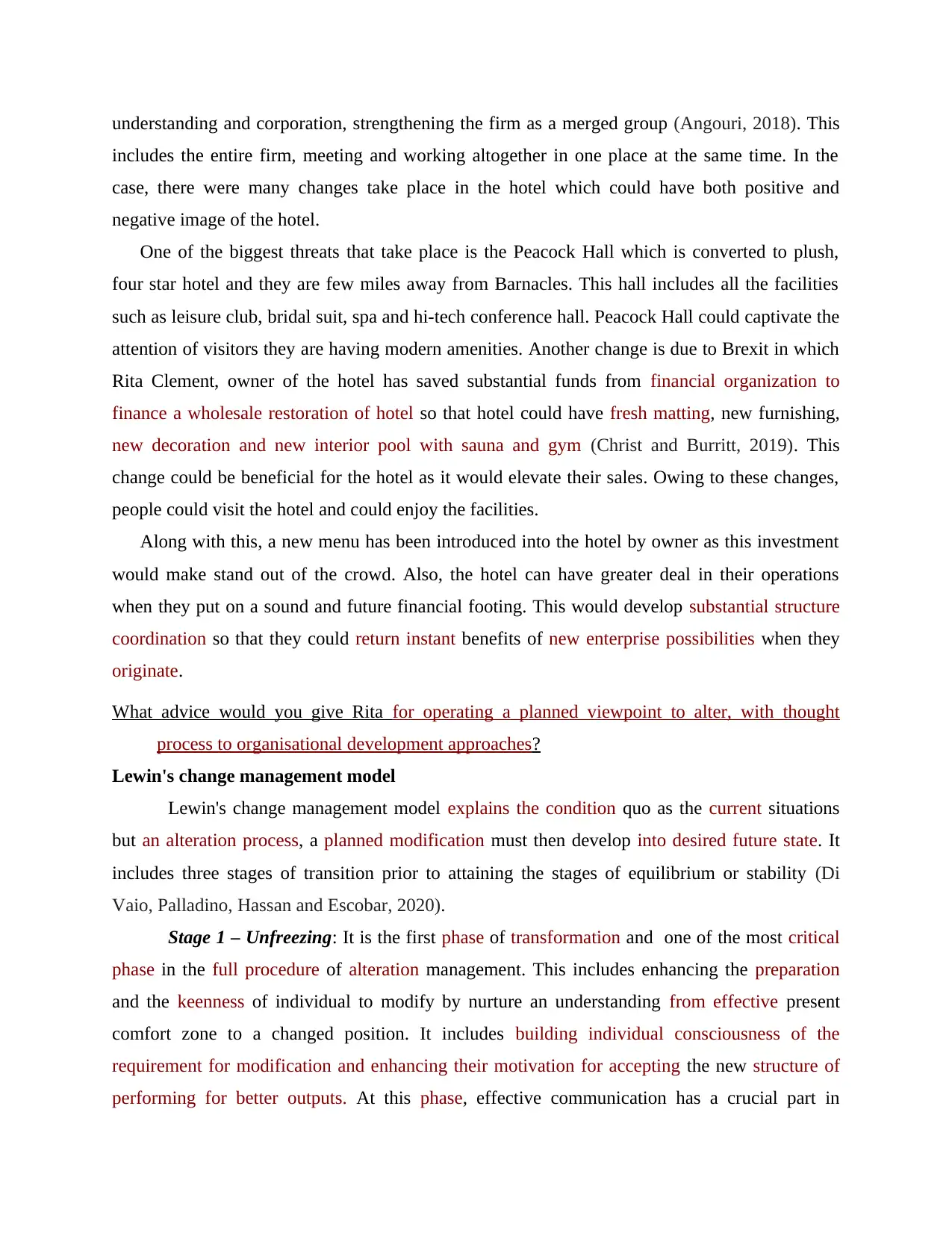
understanding and corporation, strengthening the firm as a merged group (Angouri, 2018). This
includes the entire firm, meeting and working altogether in one place at the same time. In the
case, there were many changes take place in the hotel which could have both positive and
negative image of the hotel.
One of the biggest threats that take place is the Peacock Hall which is converted to plush,
four star hotel and they are few miles away from Barnacles. This hall includes all the facilities
such as leisure club, bridal suit, spa and hi-tech conference hall. Peacock Hall could captivate the
attention of visitors they are having modern amenities. Another change is due to Brexit in which
Rita Clement, owner of the hotel has saved substantial funds from financial organization to
finance a wholesale restoration of hotel so that hotel could have fresh matting, new furnishing,
new decoration and new interior pool with sauna and gym (Christ and Burritt, 2019). This
change could be beneficial for the hotel as it would elevate their sales. Owing to these changes,
people could visit the hotel and could enjoy the facilities.
Along with this, a new menu has been introduced into the hotel by owner as this investment
would make stand out of the crowd. Also, the hotel can have greater deal in their operations
when they put on a sound and future financial footing. This would develop substantial structure
coordination so that they could return instant benefits of new enterprise possibilities when they
originate.
What advice would you give Rita for operating a planned viewpoint to alter, with thought
process to organisational development approaches?
Lewin's change management model
Lewin's change management model explains the condition quo as the current situations
but an alteration process, a planned modification must then develop into desired future state. It
includes three stages of transition prior to attaining the stages of equilibrium or stability (Di
Vaio, Palladino, Hassan and Escobar, 2020).
Stage 1 – Unfreezing: It is the first phase of transformation and one of the most critical
phase in the full procedure of alteration management. This includes enhancing the preparation
and the keenness of individual to modify by nurture an understanding from effective present
comfort zone to a changed position. It includes building individual consciousness of the
requirement for modification and enhancing their motivation for accepting the new structure of
performing for better outputs. At this phase, effective communication has a crucial part in
includes the entire firm, meeting and working altogether in one place at the same time. In the
case, there were many changes take place in the hotel which could have both positive and
negative image of the hotel.
One of the biggest threats that take place is the Peacock Hall which is converted to plush,
four star hotel and they are few miles away from Barnacles. This hall includes all the facilities
such as leisure club, bridal suit, spa and hi-tech conference hall. Peacock Hall could captivate the
attention of visitors they are having modern amenities. Another change is due to Brexit in which
Rita Clement, owner of the hotel has saved substantial funds from financial organization to
finance a wholesale restoration of hotel so that hotel could have fresh matting, new furnishing,
new decoration and new interior pool with sauna and gym (Christ and Burritt, 2019). This
change could be beneficial for the hotel as it would elevate their sales. Owing to these changes,
people could visit the hotel and could enjoy the facilities.
Along with this, a new menu has been introduced into the hotel by owner as this investment
would make stand out of the crowd. Also, the hotel can have greater deal in their operations
when they put on a sound and future financial footing. This would develop substantial structure
coordination so that they could return instant benefits of new enterprise possibilities when they
originate.
What advice would you give Rita for operating a planned viewpoint to alter, with thought
process to organisational development approaches?
Lewin's change management model
Lewin's change management model explains the condition quo as the current situations
but an alteration process, a planned modification must then develop into desired future state. It
includes three stages of transition prior to attaining the stages of equilibrium or stability (Di
Vaio, Palladino, Hassan and Escobar, 2020).
Stage 1 – Unfreezing: It is the first phase of transformation and one of the most critical
phase in the full procedure of alteration management. This includes enhancing the preparation
and the keenness of individual to modify by nurture an understanding from effective present
comfort zone to a changed position. It includes building individual consciousness of the
requirement for modification and enhancing their motivation for accepting the new structure of
performing for better outputs. At this phase, effective communication has a crucial part in
Paraphrase This Document
Need a fresh take? Get an instant paraphrase of this document with our AI Paraphraser
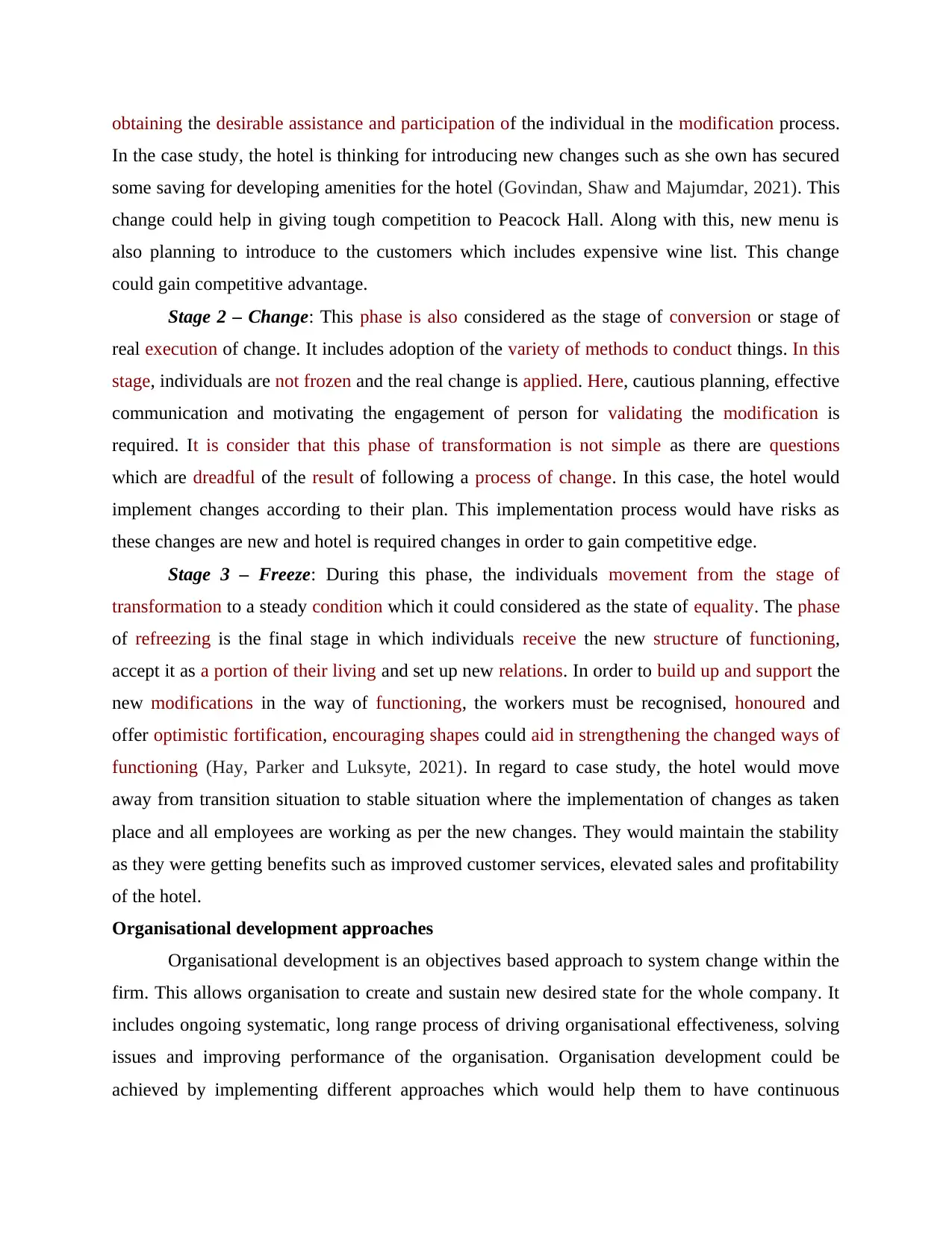
obtaining the desirable assistance and participation of the individual in the modification process.
In the case study, the hotel is thinking for introducing new changes such as she own has secured
some saving for developing amenities for the hotel (Govindan, Shaw and Majumdar, 2021). This
change could help in giving tough competition to Peacock Hall. Along with this, new menu is
also planning to introduce to the customers which includes expensive wine list. This change
could gain competitive advantage.
Stage 2 – Change: This phase is also considered as the stage of conversion or stage of
real execution of change. It includes adoption of the variety of methods to conduct things. In this
stage, individuals are not frozen and the real change is applied. Here, cautious planning, effective
communication and motivating the engagement of person for validating the modification is
required. It is consider that this phase of transformation is not simple as there are questions
which are dreadful of the result of following a process of change. In this case, the hotel would
implement changes according to their plan. This implementation process would have risks as
these changes are new and hotel is required changes in order to gain competitive edge.
Stage 3 – Freeze: During this phase, the individuals movement from the stage of
transformation to a steady condition which it could considered as the state of equality. The phase
of refreezing is the final stage in which individuals receive the new structure of functioning,
accept it as a portion of their living and set up new relations. In order to build up and support the
new modifications in the way of functioning, the workers must be recognised, honoured and
offer optimistic fortification, encouraging shapes could aid in strengthening the changed ways of
functioning (Hay, Parker and Luksyte, 2021). In regard to case study, the hotel would move
away from transition situation to stable situation where the implementation of changes as taken
place and all employees are working as per the new changes. They would maintain the stability
as they were getting benefits such as improved customer services, elevated sales and profitability
of the hotel.
Organisational development approaches
Organisational development is an objectives based approach to system change within the
firm. This allows organisation to create and sustain new desired state for the whole company. It
includes ongoing systematic, long range process of driving organisational effectiveness, solving
issues and improving performance of the organisation. Organisation development could be
achieved by implementing different approaches which would help them to have continuous
In the case study, the hotel is thinking for introducing new changes such as she own has secured
some saving for developing amenities for the hotel (Govindan, Shaw and Majumdar, 2021). This
change could help in giving tough competition to Peacock Hall. Along with this, new menu is
also planning to introduce to the customers which includes expensive wine list. This change
could gain competitive advantage.
Stage 2 – Change: This phase is also considered as the stage of conversion or stage of
real execution of change. It includes adoption of the variety of methods to conduct things. In this
stage, individuals are not frozen and the real change is applied. Here, cautious planning, effective
communication and motivating the engagement of person for validating the modification is
required. It is consider that this phase of transformation is not simple as there are questions
which are dreadful of the result of following a process of change. In this case, the hotel would
implement changes according to their plan. This implementation process would have risks as
these changes are new and hotel is required changes in order to gain competitive edge.
Stage 3 – Freeze: During this phase, the individuals movement from the stage of
transformation to a steady condition which it could considered as the state of equality. The phase
of refreezing is the final stage in which individuals receive the new structure of functioning,
accept it as a portion of their living and set up new relations. In order to build up and support the
new modifications in the way of functioning, the workers must be recognised, honoured and
offer optimistic fortification, encouraging shapes could aid in strengthening the changed ways of
functioning (Hay, Parker and Luksyte, 2021). In regard to case study, the hotel would move
away from transition situation to stable situation where the implementation of changes as taken
place and all employees are working as per the new changes. They would maintain the stability
as they were getting benefits such as improved customer services, elevated sales and profitability
of the hotel.
Organisational development approaches
Organisational development is an objectives based approach to system change within the
firm. This allows organisation to create and sustain new desired state for the whole company. It
includes ongoing systematic, long range process of driving organisational effectiveness, solving
issues and improving performance of the organisation. Organisation development could be
achieved by implementing different approaches which would help them to have continuous
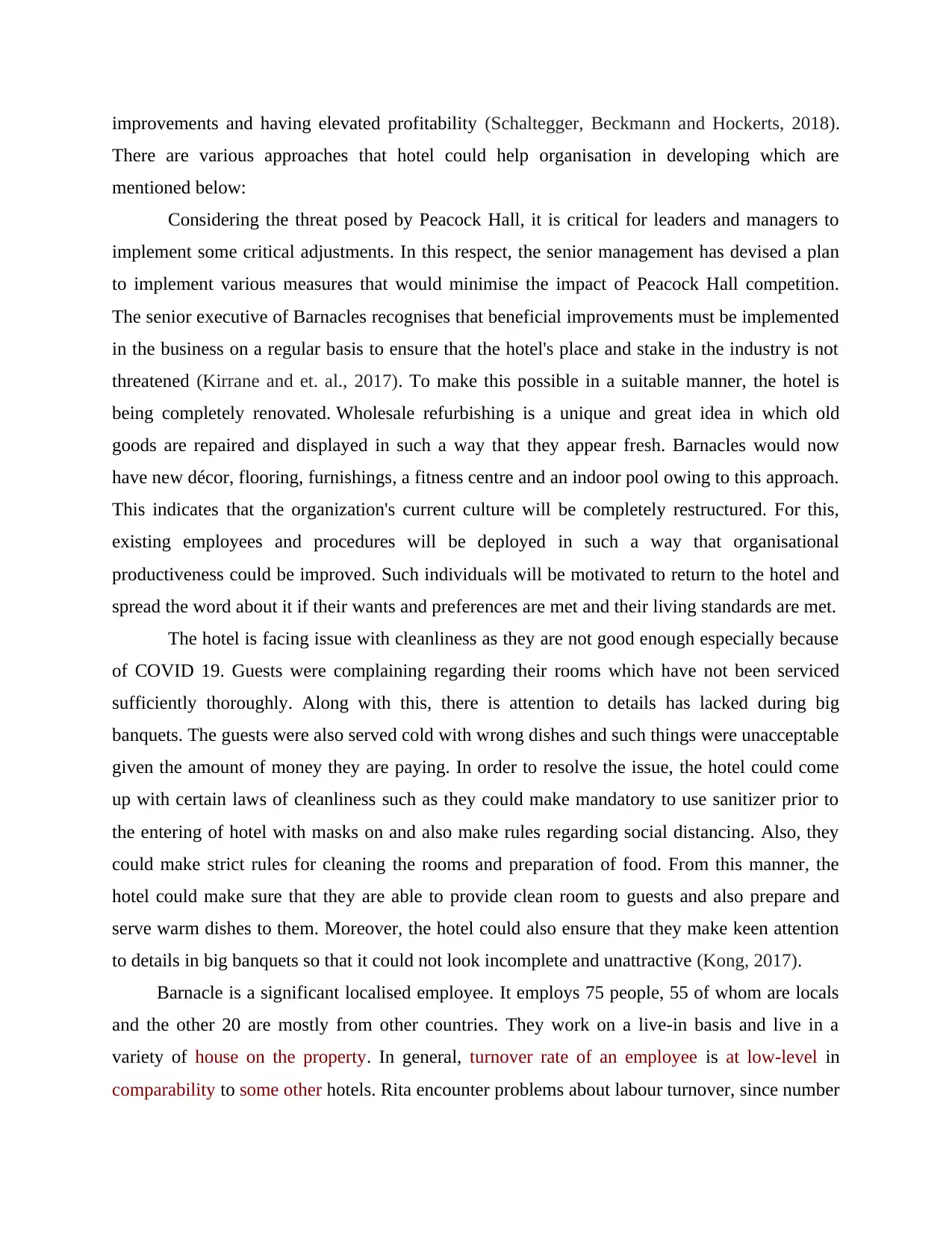
improvements and having elevated profitability (Schaltegger, Beckmann and Hockerts, 2018).
There are various approaches that hotel could help organisation in developing which are
mentioned below:
Considering the threat posed by Peacock Hall, it is critical for leaders and managers to
implement some critical adjustments. In this respect, the senior management has devised a plan
to implement various measures that would minimise the impact of Peacock Hall competition.
The senior executive of Barnacles recognises that beneficial improvements must be implemented
in the business on a regular basis to ensure that the hotel's place and stake in the industry is not
threatened (Kirrane and et. al., 2017). To make this possible in a suitable manner, the hotel is
being completely renovated. Wholesale refurbishing is a unique and great idea in which old
goods are repaired and displayed in such a way that they appear fresh. Barnacles would now
have new décor, flooring, furnishings, a fitness centre and an indoor pool owing to this approach.
This indicates that the organization's current culture will be completely restructured. For this,
existing employees and procedures will be deployed in such a way that organisational
productiveness could be improved. Such individuals will be motivated to return to the hotel and
spread the word about it if their wants and preferences are met and their living standards are met.
The hotel is facing issue with cleanliness as they are not good enough especially because
of COVID 19. Guests were complaining regarding their rooms which have not been serviced
sufficiently thoroughly. Along with this, there is attention to details has lacked during big
banquets. The guests were also served cold with wrong dishes and such things were unacceptable
given the amount of money they are paying. In order to resolve the issue, the hotel could come
up with certain laws of cleanliness such as they could make mandatory to use sanitizer prior to
the entering of hotel with masks on and also make rules regarding social distancing. Also, they
could make strict rules for cleaning the rooms and preparation of food. From this manner, the
hotel could make sure that they are able to provide clean room to guests and also prepare and
serve warm dishes to them. Moreover, the hotel could also ensure that they make keen attention
to details in big banquets so that it could not look incomplete and unattractive (Kong, 2017).
Barnacle is a significant localised employee. It employs 75 people, 55 of whom are locals
and the other 20 are mostly from other countries. They work on a live-in basis and live in a
variety of house on the property. In general, turnover rate of an employee is at low-level in
comparability to some other hotels. Rita encounter problems about labour turnover, since number
There are various approaches that hotel could help organisation in developing which are
mentioned below:
Considering the threat posed by Peacock Hall, it is critical for leaders and managers to
implement some critical adjustments. In this respect, the senior management has devised a plan
to implement various measures that would minimise the impact of Peacock Hall competition.
The senior executive of Barnacles recognises that beneficial improvements must be implemented
in the business on a regular basis to ensure that the hotel's place and stake in the industry is not
threatened (Kirrane and et. al., 2017). To make this possible in a suitable manner, the hotel is
being completely renovated. Wholesale refurbishing is a unique and great idea in which old
goods are repaired and displayed in such a way that they appear fresh. Barnacles would now
have new décor, flooring, furnishings, a fitness centre and an indoor pool owing to this approach.
This indicates that the organization's current culture will be completely restructured. For this,
existing employees and procedures will be deployed in such a way that organisational
productiveness could be improved. Such individuals will be motivated to return to the hotel and
spread the word about it if their wants and preferences are met and their living standards are met.
The hotel is facing issue with cleanliness as they are not good enough especially because
of COVID 19. Guests were complaining regarding their rooms which have not been serviced
sufficiently thoroughly. Along with this, there is attention to details has lacked during big
banquets. The guests were also served cold with wrong dishes and such things were unacceptable
given the amount of money they are paying. In order to resolve the issue, the hotel could come
up with certain laws of cleanliness such as they could make mandatory to use sanitizer prior to
the entering of hotel with masks on and also make rules regarding social distancing. Also, they
could make strict rules for cleaning the rooms and preparation of food. From this manner, the
hotel could make sure that they are able to provide clean room to guests and also prepare and
serve warm dishes to them. Moreover, the hotel could also ensure that they make keen attention
to details in big banquets so that it could not look incomplete and unattractive (Kong, 2017).
Barnacle is a significant localised employee. It employs 75 people, 55 of whom are locals
and the other 20 are mostly from other countries. They work on a live-in basis and live in a
variety of house on the property. In general, turnover rate of an employee is at low-level in
comparability to some other hotels. Rita encounter problems about labour turnover, since number
⊘ This is a preview!⊘
Do you want full access?
Subscribe today to unlock all pages.

Trusted by 1+ million students worldwide
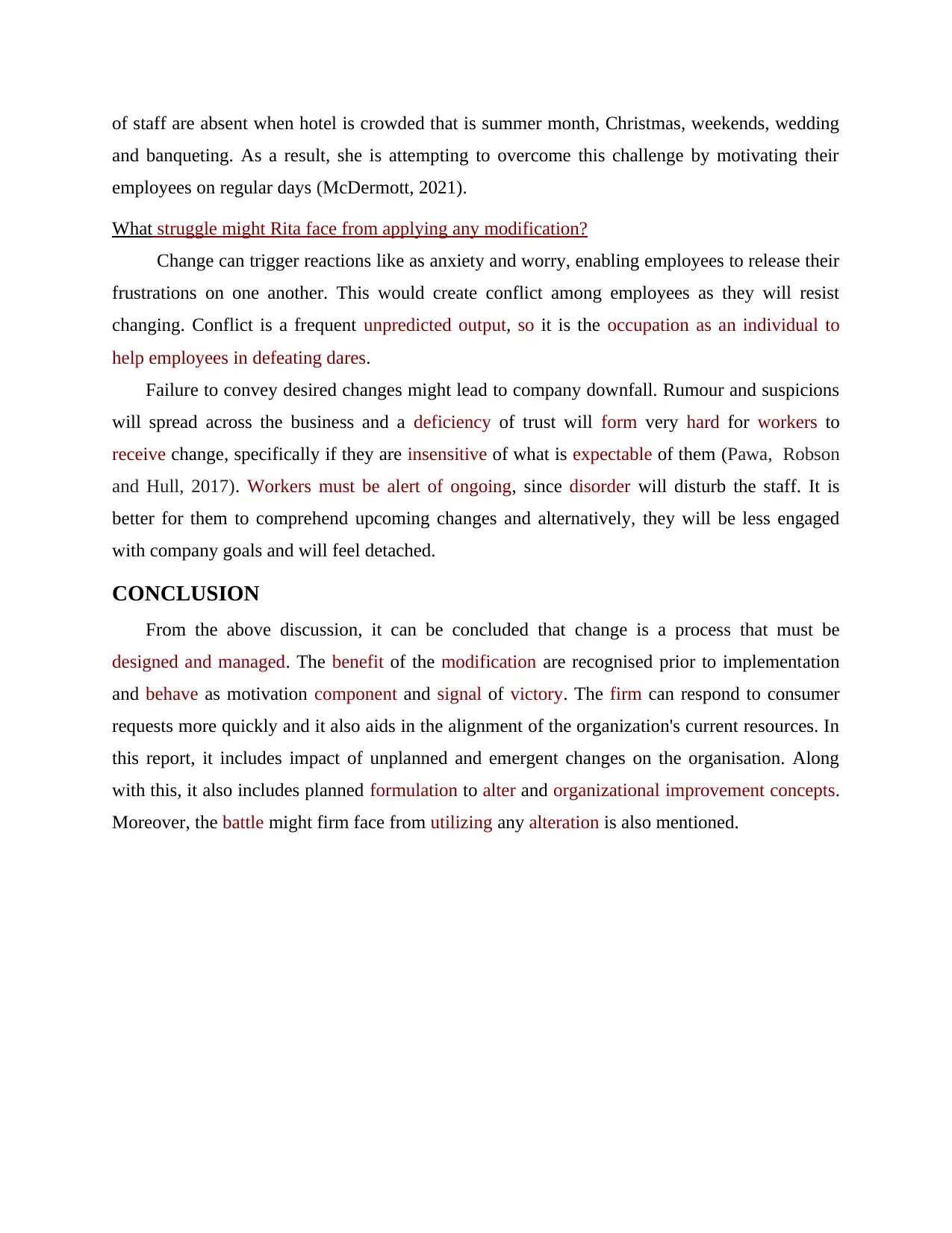
of staff are absent when hotel is crowded that is summer month, Christmas, weekends, wedding
and banqueting. As a result, she is attempting to overcome this challenge by motivating their
employees on regular days (McDermott, 2021).
What struggle might Rita face from applying any modification?
Change can trigger reactions like as anxiety and worry, enabling employees to release their
frustrations on one another. This would create conflict among employees as they will resist
changing. Conflict is a frequent unpredicted output, so it is the occupation as an individual to
help employees in defeating dares.
Failure to convey desired changes might lead to company downfall. Rumour and suspicions
will spread across the business and a deficiency of trust will form very hard for workers to
receive change, specifically if they are insensitive of what is expectable of them (Pawa, Robson
and Hull, 2017). Workers must be alert of ongoing, since disorder will disturb the staff. It is
better for them to comprehend upcoming changes and alternatively, they will be less engaged
with company goals and will feel detached.
CONCLUSION
From the above discussion, it can be concluded that change is a process that must be
designed and managed. The benefit of the modification are recognised prior to implementation
and behave as motivation component and signal of victory. The firm can respond to consumer
requests more quickly and it also aids in the alignment of the organization's current resources. In
this report, it includes impact of unplanned and emergent changes on the organisation. Along
with this, it also includes planned formulation to alter and organizational improvement concepts.
Moreover, the battle might firm face from utilizing any alteration is also mentioned.
and banqueting. As a result, she is attempting to overcome this challenge by motivating their
employees on regular days (McDermott, 2021).
What struggle might Rita face from applying any modification?
Change can trigger reactions like as anxiety and worry, enabling employees to release their
frustrations on one another. This would create conflict among employees as they will resist
changing. Conflict is a frequent unpredicted output, so it is the occupation as an individual to
help employees in defeating dares.
Failure to convey desired changes might lead to company downfall. Rumour and suspicions
will spread across the business and a deficiency of trust will form very hard for workers to
receive change, specifically if they are insensitive of what is expectable of them (Pawa, Robson
and Hull, 2017). Workers must be alert of ongoing, since disorder will disturb the staff. It is
better for them to comprehend upcoming changes and alternatively, they will be less engaged
with company goals and will feel detached.
CONCLUSION
From the above discussion, it can be concluded that change is a process that must be
designed and managed. The benefit of the modification are recognised prior to implementation
and behave as motivation component and signal of victory. The firm can respond to consumer
requests more quickly and it also aids in the alignment of the organization's current resources. In
this report, it includes impact of unplanned and emergent changes on the organisation. Along
with this, it also includes planned formulation to alter and organizational improvement concepts.
Moreover, the battle might firm face from utilizing any alteration is also mentioned.
Paraphrase This Document
Need a fresh take? Get an instant paraphrase of this document with our AI Paraphraser
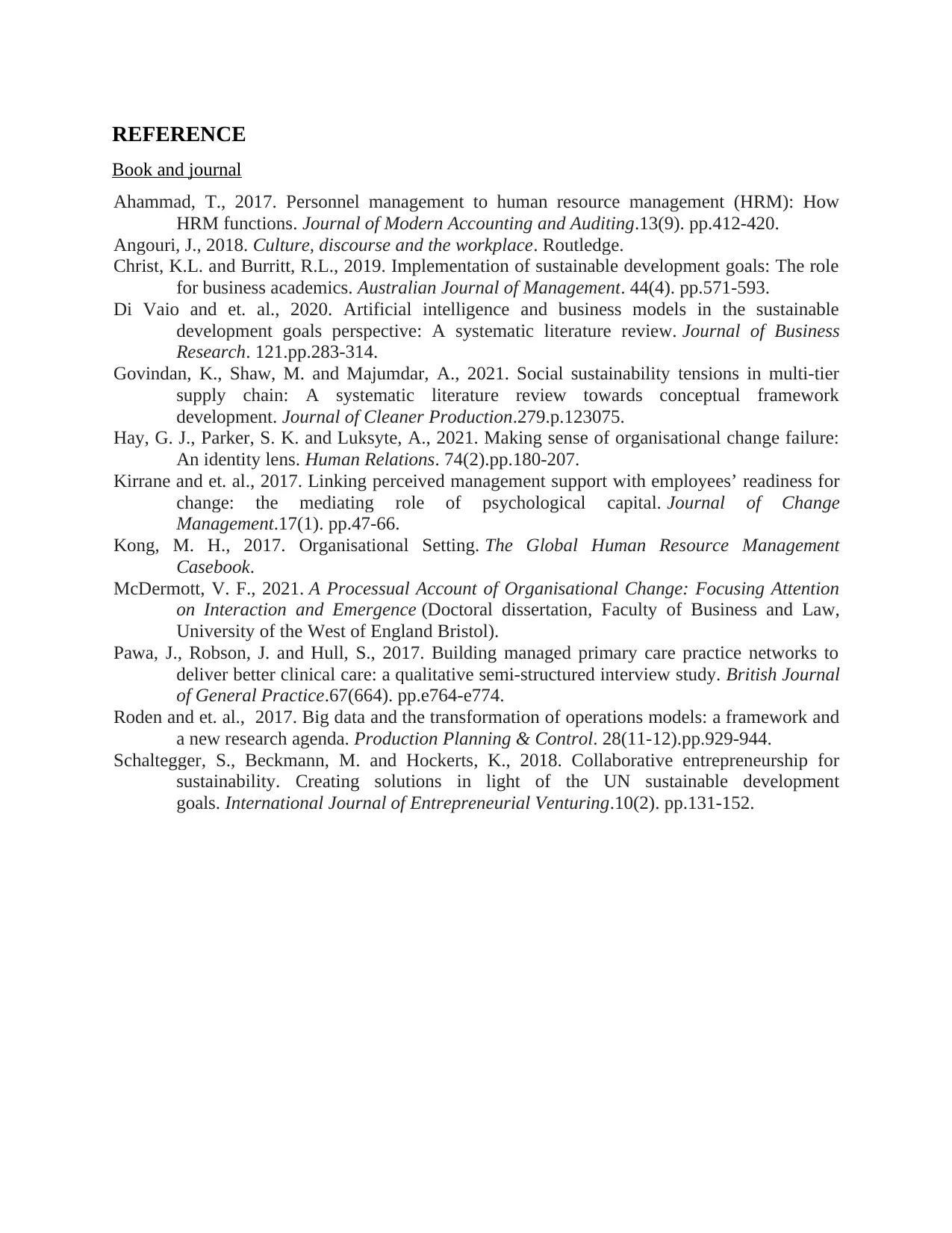
REFERENCE
Book and journal
Ahammad, T., 2017. Personnel management to human resource management (HRM): How
HRM functions. Journal of Modern Accounting and Auditing.13(9). pp.412-420.
Angouri, J., 2018. Culture, discourse and the workplace. Routledge.
Christ, K.L. and Burritt, R.L., 2019. Implementation of sustainable development goals: The role
for business academics. Australian Journal of Management. 44(4). pp.571-593.
Di Vaio and et. al., 2020. Artificial intelligence and business models in the sustainable
development goals perspective: A systematic literature review. Journal of Business
Research. 121.pp.283-314.
Govindan, K., Shaw, M. and Majumdar, A., 2021. Social sustainability tensions in multi-tier
supply chain: A systematic literature review towards conceptual framework
development. Journal of Cleaner Production.279.p.123075.
Hay, G. J., Parker, S. K. and Luksyte, A., 2021. Making sense of organisational change failure:
An identity lens. Human Relations. 74(2).pp.180-207.
Kirrane and et. al., 2017. Linking perceived management support with employees’ readiness for
change: the mediating role of psychological capital. Journal of Change
Management.17(1). pp.47-66.
Kong, M. H., 2017. Organisational Setting. The Global Human Resource Management
Casebook.
McDermott, V. F., 2021. A Processual Account of Organisational Change: Focusing Attention
on Interaction and Emergence (Doctoral dissertation, Faculty of Business and Law,
University of the West of England Bristol).
Pawa, J., Robson, J. and Hull, S., 2017. Building managed primary care practice networks to
deliver better clinical care: a qualitative semi-structured interview study. British Journal
of General Practice.67(664). pp.e764-e774.
Roden and et. al., 2017. Big data and the transformation of operations models: a framework and
a new research agenda. Production Planning & Control. 28(11-12).pp.929-944.
Schaltegger, S., Beckmann, M. and Hockerts, K., 2018. Collaborative entrepreneurship for
sustainability. Creating solutions in light of the UN sustainable development
goals. International Journal of Entrepreneurial Venturing.10(2). pp.131-152.
Book and journal
Ahammad, T., 2017. Personnel management to human resource management (HRM): How
HRM functions. Journal of Modern Accounting and Auditing.13(9). pp.412-420.
Angouri, J., 2018. Culture, discourse and the workplace. Routledge.
Christ, K.L. and Burritt, R.L., 2019. Implementation of sustainable development goals: The role
for business academics. Australian Journal of Management. 44(4). pp.571-593.
Di Vaio and et. al., 2020. Artificial intelligence and business models in the sustainable
development goals perspective: A systematic literature review. Journal of Business
Research. 121.pp.283-314.
Govindan, K., Shaw, M. and Majumdar, A., 2021. Social sustainability tensions in multi-tier
supply chain: A systematic literature review towards conceptual framework
development. Journal of Cleaner Production.279.p.123075.
Hay, G. J., Parker, S. K. and Luksyte, A., 2021. Making sense of organisational change failure:
An identity lens. Human Relations. 74(2).pp.180-207.
Kirrane and et. al., 2017. Linking perceived management support with employees’ readiness for
change: the mediating role of psychological capital. Journal of Change
Management.17(1). pp.47-66.
Kong, M. H., 2017. Organisational Setting. The Global Human Resource Management
Casebook.
McDermott, V. F., 2021. A Processual Account of Organisational Change: Focusing Attention
on Interaction and Emergence (Doctoral dissertation, Faculty of Business and Law,
University of the West of England Bristol).
Pawa, J., Robson, J. and Hull, S., 2017. Building managed primary care practice networks to
deliver better clinical care: a qualitative semi-structured interview study. British Journal
of General Practice.67(664). pp.e764-e774.
Roden and et. al., 2017. Big data and the transformation of operations models: a framework and
a new research agenda. Production Planning & Control. 28(11-12).pp.929-944.
Schaltegger, S., Beckmann, M. and Hockerts, K., 2018. Collaborative entrepreneurship for
sustainability. Creating solutions in light of the UN sustainable development
goals. International Journal of Entrepreneurial Venturing.10(2). pp.131-152.
1 out of 8
Related Documents
Your All-in-One AI-Powered Toolkit for Academic Success.
+13062052269
info@desklib.com
Available 24*7 on WhatsApp / Email
![[object Object]](/_next/static/media/star-bottom.7253800d.svg)
Unlock your academic potential
Copyright © 2020–2025 A2Z Services. All Rights Reserved. Developed and managed by ZUCOL.



